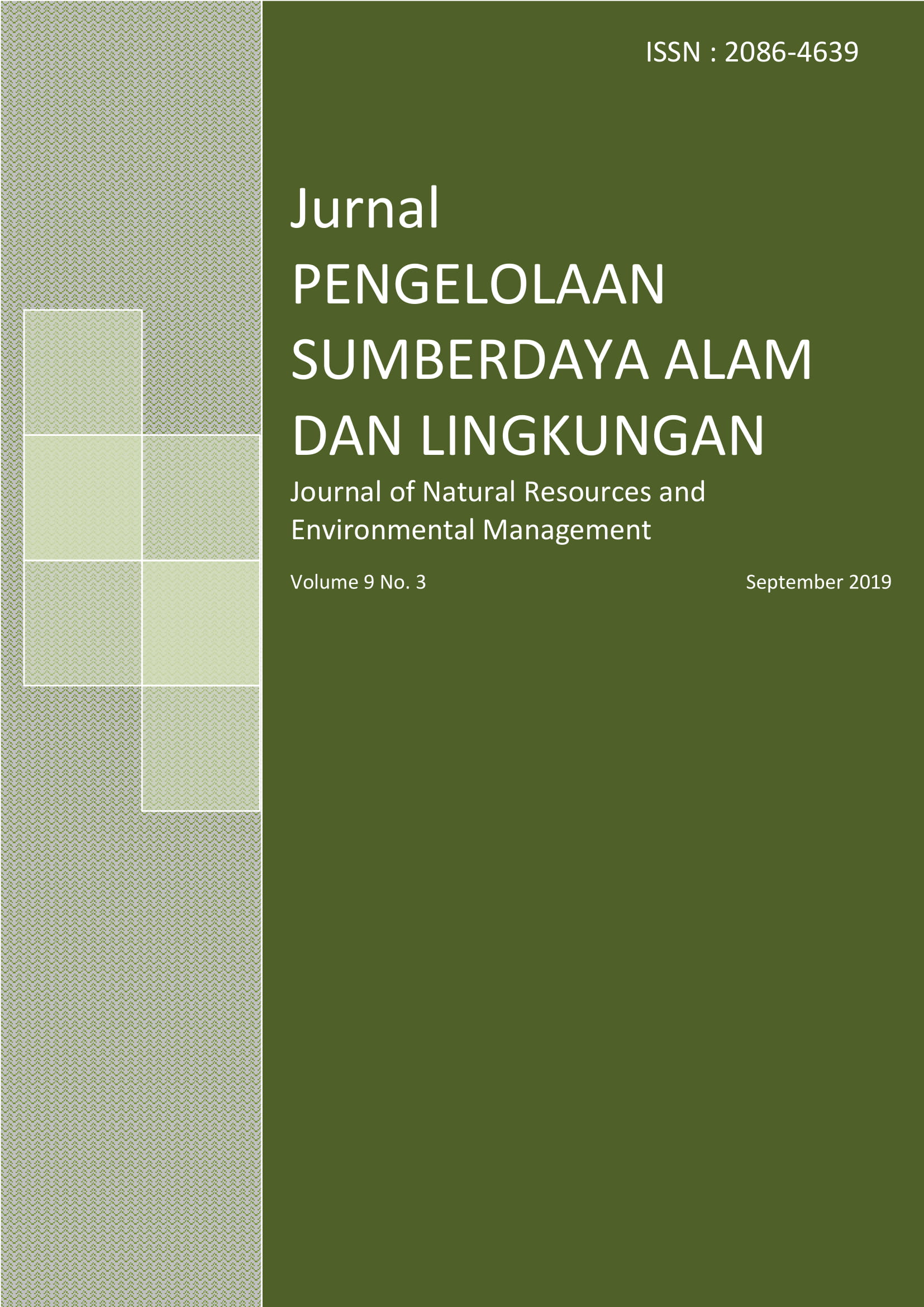Mitigasi Dan Arahan Pengelolaan Air Asam Tambang Melalui Hutan Rawa Buatan Di Lahan Pasca Tambang
Abstract
References
Alibasyah R. 2016. Perubahan beberapa sifat fisika dan kimia ultisol akibat pemberian pupuk kompos dan kapur dolomit pada lahan berteras. Jurnal Floratek. 11(1): 75-87.
Bonanno G, Cirelli GL. 2017. Comparative analysis of element concentrations and translocation in three wetland congener plants: Typha domingensis, Typha latifolia and Typha angustifolia. Ecotoxicology and Environmental Safety. 143(1): 92 – 101. doi:10.1016/j.ecoenv.2017.05.021.
Chunkao K, Nimpee C, Duangmal K. 2012. The King’s initiatives using water hyacinth to remove heavy metals and plant nutrients from wastewater through Bueng Makkasan in Bangkok Thailand. Ecological Engineering. 39 (1): 40 – 52. doi:10.1016/j.ecoleng.2011.09.006.
Denholm CP, T P Danehy, M H. Dunn, S L Busler, C A. Neely, R M. Mahony, D A. Guy. 2016. Long-Term Effectiveness Of Three Passive Systems Treating Acidic, High-Metal, Abandoned Coal Mine Discharges Near De Sale, Pennsylvania [Internet]. [33rd Annual Meeting of the ASMR, June 4-9, 2016, Spokane, Washington]. Washington: ASMR.; [diunduh 2017 Okt 7]. Tersedia pada: https://www.asmr.us/Portals/0/Documents/Meetings/2016/16-01-Denholm.pdf.
Dhir B. 2013. Phytoremediation: Role of Aquatic Plants in Environmental CleanUp. New Delhi: Springer.
Direktorat Jenderal Mineral dan Batubara. 2013. Kumpulan Pedoman Teknis Lingkungan Pertambangan. Kementerian Energi dan Sumber Daya Mineral. Jakarta (31): Direktorat Jenderal Mineral dan Batubara.
Gautam M, Agrawal M. 2017. Phytoremediation of metals using vetiver (Chrysopogon zizanioides (L.) Roberty) grown under different levels of red mud in sludge amended soil. Geochemical Exploration. doi:10.1016/j.gexplo.2017.03.003.
Hairiah K, Sardjono MA, Sabarnurdin S. 2003. 4 Pemecahan Masalah: Upaya Menuju Pertanian Berkelanjutan. [Internet]. [Waktu dan tempat pertemuan tidak diketahui]. Bogor: [diunduh 2017 Okt 5]. Tersedia pada: http://www.worldagroforestry.org/SEA/Publications/Files/ book/BK0028-04/BK0028-04-3.pdf.
Iskandar, Sujatmiko, and Gautama RS. 2011. Acid Mine Drainage Management in Indonesian Mines [Internet]. [7th Australian Workshop on AMD held in Darwin on June 21-24, 2011]. Darwin (AU): [diunduh 2017 Okt 5]. Tersedia pada: https://amdworkshop.com.au/files/1168/7th%20AMD %20Front%20Pages%20of%20Proceedings.pdf
Juniarto A. 2017. Kompos Tandan Kosong Sawit untuk Meningkatkan Pertumbuhan Samama (Neolamarckia macrophylla Roxb.) di Lahan Pasca Tambang Batubara [tesis]. Bogor: Institut Pertanian Bogor.
Mays PA, Edwards GS. 2001. Comparisaon of Heavy metal accumulation in natural wetland and constructed wetlands receiving acid mine drainage. Ecol Eng. 16(4):487-500. doi:10.1016/S0925-8574(00)00112-9.
Muzaiyanah S dan Subandi. 2016. Peranan bahan organik dalam peningkatan produksi kedelai dan ubi kayu pada lahan kering masam. Jurnal Iptek Tanaman Pangan. 11(2): 149 -158.
Nairm 2016. Comprehensive Watershed Restoration via Ecological Engineering: The Role of Passive Treatment. [Internet]. [33rd Annual Meeting of the ASMR, June 4-9, 2016, Spokane, Washington]. Washington: ASMR.; [diunduh 2017 Okt 7]. Tersedia pada: https://www.asmr.us/Portals/0/ Documents/Meetings/2016/13-02-Nairn.pdf
Norton PJ. 1992. The control of acid mine drainage with wetlands. Mine Water Environ. 11(3):27-34. doi:10.1007/BF02914814.
Nurjanah AS. 2014. Potensi Simpanan Karbon Pada Tegakan Revegetasi Lahan Pasca Tambang PT Jorong Barutama Greston, Kalimantan Selatan [skripsi]. Bogor: Institut Pertanian Bogor.
Rafsanjani A. 2015. Pengaruh Bahan Organik Terhadap Eh dan pH, serta Korelasinya terhadap P Tersedia pada Tanah yang Digenangi [skripsi]. Bogor: Institut Pertanian Bogor.
Sasaki K, Ogino T, Endo Y, Kurosawa K. 2003. Field study on heavy metal acumulation in natural wetland receiving acid mine drainage. Mater Trans. 44(9):1877-1884.
Scheneider IAH, Rubio J, Misra M, Smith RW. 1995. Eichhornia Crassipes as biosorbent for heavy metal ions. Miner Eng. 8(9): 979 – 988. doi: 10.1016/0892-6875(95)00061-T.
Sengupta M. 1993. Environmental Impacts Of Mining, Monitoring, Restoration, And Control. New York: Lewis Publishers.
Sheoran AS, Sheoran V. 2006. Heavy metal removal mechanism of acid mine drainage in wetlands: A critical review. Miner Eng. 19(2):105-116. doi: 10.1016/j.mineng.2005.08.006.
Tuheteru FD. 2015. Potensi Lonkida (Nauclea Orientalis L.) Untuk Fitoremediasi Lahan Basah Air Asam Tambang [disertasi]. Bogor: Institut Pertanian Bogor.
Wetland Stewarship Partnership. 2009. Wetland Ways; Interim Guidelines for Wetland Protection and Conservation in British Colombia. Chapter 11: Wetland Enhancement and Restoration. British Colombia: Environmental Stewardship Division.
Widiyatmoko R, Wasis B, Prasetyo LB. 2017. Analisis pertumbuhan tanaman revegetasi di lahan bekas tambang silika holcim educational forest Cibadak, Sukabumi, Jawa Barat. Jurnal Pengelolaan Sumberdaya Alam dan Lingkungan. 7(1): 79-88. doi : 10.19081/jpsl.2017.7.1.79.
Authors
Authors who publish with this journal agree to the following terms:
- Authors retain copyright and grant the journal right of first publication with the work simultaneously licensed under a Creative Commons Attribution License that allows others to share the work with an acknowledgement of the work's authorship and initial publication in this journal.
- Authors are able to enter into separate, additional contractual arrangements for the non-exclusive distribution of the journal's published version of the work (e.g., post it to an institutional repository or publish it in a book), with an acknowledgement of its initial publication in this journal.
- Authors are permitted and encouraged to post their work online (e.g., in institutional repositories or on their website) prior to and during the submission process, as it can lead to productive exchanges, as well as earlier and greater citation of published work (See The Effect of Open Access).






